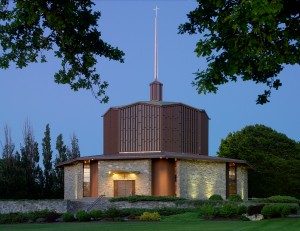
Photo Credit: Aaron Usher
The Connecticut Chapter of the American Institute of Architects recently announced the winners of their 2013 Design Competition. Church of Saint Gregory The Great at Portsmouth Abbey in Portsmouth, RI earned the Honor Award in the Preservation Category.
Modernist Pietro Belluschi worked with sculptor Richard Lippold, craftsman George Nakashima, and glass designer Henry Lee Willett in 1960 to create an icon of ecclesiastical architecture. Church of St. Gregory the Great sits on a platform and symbolizes Benedictine Monks’ cultivation of learning, liturgy, and conservation. The octagonal church with a 28’ clerestory recalls San Vitale built in the 1500s. Stone walls, redwood board and batten, stained glass, and copper roofs reflect Pacific Northwestern, Scandinavian, and Japanese designs.
The church’s engineering lacked the lateral stability needed to withstand the harsh coastal climate. Needed restoration was not apparent to casual observers; but chronic leaking that compromised the structural integrity worried the monks who prayed there daily. The Abbey launched a seven year, $4 million restoration. The design team reinforced the structure, refurbished the 60’ spire, improved energy efficiency, and added new chandeliers without altering Belluschi’s aesthetic. The clerestory presented the greatest challenge. Extensive water damage warranted that all 136 of the 28’ clerestory frames be replaced. Old growth timber was shipped from Vancouver; then kiln dried, milled, primed, installed and painted. To ensure the original glass pattern was not lost, 2,960 pieces mounted between the framework were labeled, cataloged, removed, cleaned, and reassembled.
Structural deficiencies also threatened the sculpture. Lippold wove Trinity into space with 22,000’ of golden wire sewn through aluminum bars on their way from the cross to the church’s columns and ceiling. The 2,000 wires and 5,000 joints make 11 triangular arrays that radiate from the cross suspended 10’ above the altar across 12,000 cubic ft. Trinity was dusty, corroded and collapsing. Art restorers treated the arrays like boat sails, clamping their ends, then cutting and lowering them. They replaced all the wires on a giant loom, returned to the church, and remounted them all.
